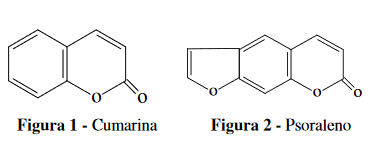Análises de cumarinas em derivados de citrus utilizando cromatografia gasosa de alta resolução com sistemas de detecção por ionização de chama e espectrometria de massas
DOI:
https://doi.org/10.20873/jbb.uft.cemaf.v3n1.novaPalabras clave:
Coumarins, derivados de Citrus, HRGC-MSDResumen
As plantas cítricas, em especial a laranja, possuem grande importância para a economia brasileira, com destaque à região Sudeste do país. Os óleos essenciais de Citrus constituem um dos mais importantes grupos de matérias primas para várias indústrias, principalmente as de alimentos, farmacêuticas e de perfumaria. Na área de alimentos, o óleo essencial de laranja é usado para realçar o “flavor” do suco e exportado para o exterior, mais especificamente para os Estados Unidos (principal consumidor). Neste trabalho desenvolveu-se uma metodologia analítica para identificação e quantificação de cumarinas em derivados de plantas cítricas (óleos, ceras) utilizando-se técnicas cromatográficas tais como cromatografia gasosa de alta resolução com sistema de detecção por ionização de chama (HRGC-FID) e sistema de detecção por espectrometria de massas (HRGC-MS). Os resultados obtidos na análise qualitativa utilizando o sistema HRGC-MS empregando o monitoramento do íon seletivo (SIM) indicaram a presença de cumarina nas amostras de óleo essencial e na amostra de cera foi detectada a presença de cumarina e de psoraleno. As análises quantitativas empregando os métodos do padrão externo, padrão interno e adição de padrão apresentaram bons resultados, em especial o método do padrão interno, o qual apresentou maior repetibilidade.
Citas
Simões, C. M. e SPitzer, V. (1999), Óleos essenciais. In: Simões, C. M. O.; Schenckel, E. P.; Gosmman, G.; Mello, J. C. P. Farmacognosia. Da planta ao medicamento. Porto Alegre/ Florianópolis. Ed. UFRGS/UFSC, 387-415.
Kuster, R. M. e Roche, L. M. (2001), Cumarinas, cromonas e xantonas. In: Simões, C. M. O.; Schenckel, E. P.; Gosmman, G. Farmacognosia: Da planta ao medicamento. Porto Alegre/ Florianópolis. Ed. UFRGS/UFSC, 461-479.
Biavatte, M. W.; Koorich, C. A.; Zucatelli, E.; Martinelli, F. H.; Bresolin, T. B.; Leite, S. N. (2004), Coumarin content and physicochemical profile of Mikania levigata extracts. Zetschrft fur Naturforschung, 59, 178-187.
Tanaka, T. (2005), (Semi-centennial commemoration papers on citrus studies). In: Mattos Junior, D.; Negri, J. D.; Pio, R. M.; Pompeu, J. Citros. Cordeirópolis. Centro APTA Citros Sylvio Moreira. 322-334.
Swingle, W. T. e Reece, P. C. (2005), The botany of Citrus and its wild relative. In: Mattos Junior, D.; Negri, J. D.; Pio, R. M.; Pompeu Junior, J. Citros. Cordeirópolis. Centro APTA Citros Sylvio Moreira. 156-163.
De Miranda, J. A. Caracterização fotofísica de derivados de cumarinas. Dissertação Mestrado em Química - Universidade Federal de Uberlândia, 2009.
Robards, K. e Antolovich , M. (1995), Coumarin and Kaurenoic acid. Analyst, 120-124.
Moshonas , M. G.; Shaw , P. E. (1994). Mikania levigata extracts. Journal of Agricultural and Food Chemistry, 42, 1525-1528.
Eight Peak Index of Mass Spectra. (1986), The Royal Society of Chemistry, London, 2. 246-279.
Vilegas, J. H. Y.; De Marchi, E.; Lanças, F. M. (1997), Determination of coumarin and Kaurenoic acid in Mikania glomerata (guaco) leaves by capillary gas chromatography. Phitochemical Analysis, 8, 74-77.
Loghkin, A. V. e Sckanyan, E. I. (2006). Natural coumarin: methods of isolation and analysis. Pharmaceutical Chemistry Journal. 40, 337-346.
Pathak, M. A. e Fitzpatrick, T. B. (1992), Determination of coumarin in citrus. Journal of Photochemistry and Photobiology. B, 14, 3-22. Microcal Origin, Version 4. (1996). Microcal Software Inc. New York.
Ribani, M.; Botolli, C. B. G.; Collins, C. H.; Jardim, I. C. S. F.; Melo, L. F. C. (2004), Validaçào em métodos cromatográficos e eletroforéticos. Quimica Nova, 27, 01-10.

Publicado
Cómo citar
Número
Sección
Licencia
Copyright (c) 2024 - Journal of Biotechnology and Biodiversity

Esta obra está bajo una Licencia Creative Commons Atribución 4.0 Internacional.
Los autores que publican en esta revista aceptan los siguientes términos:
Los autores mantienen los derechos autorales y conceden a la revista el derecho de primera publicación, con el trabajo simultáneamente licenciado bajo la LicenciaCreative Commons Attribution (CC BY 4.0 en el link http://creativecommons.org/licenses/by/4.0/) que permite compartir el trabajo con reconocimiento de la autoría y publicación inicial en esta revista.
Los autores tienen autorización para asumir contratos adicionales separadamente, para distribución no exclusiva de la versión del trabajo publicado en esta revista (ej.: publicar en repositorio institucional o como capítulo de libro), con reconocimiento de autoría y publicación inicial en esta revista.
A los autores se les permite, y son estimulados, a publicar y distribuir su trabajo online (ej.: en repositorios institucionales o en su página personal) en cualquier punto antes o durante el proceso editorial, ya que esto puede generar alteraciones productivas, bien como aumentar el impacto y la citación del trabajo publicado (disponible en El Efecto del Acceso Libre en el link http://opcit.eprints.org/oacitation-biblio.html).


